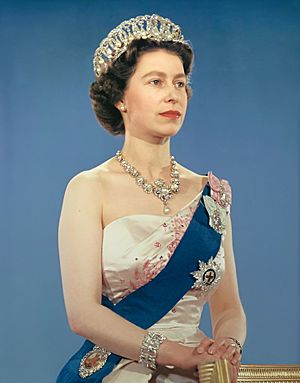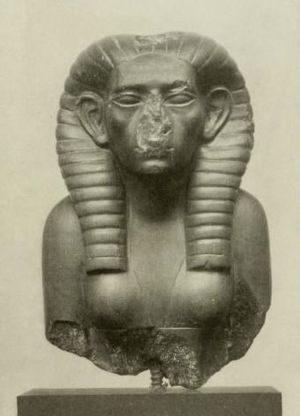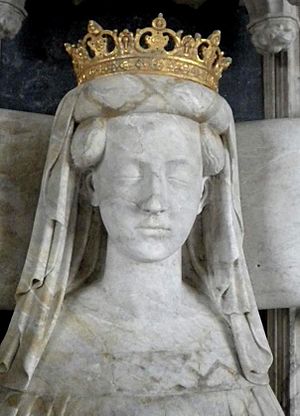Queen regnant facts for kids

A queen regnant is a female ruler who holds the same power and title as a king. She rules a kingdom in her own right, meaning she inherited the throne directly. This is different from a queen consort, who is married to a king but does not rule. It's also different from a queen regent, who rules only for a short time, usually when a child monarch is too young to rule or when her husband is away.
A queen regnant has full power over her country. A queen consort or queen regent shares the rank and titles of her husband or child, but not the actual power. The husband of a queen regnant usually does not share her ruling power or title. However, sometimes a "king consort" or "prince consort" title is used for the husband of a queen regnant.
A queen dowager is the widow of a king. A queen mother is a queen dowager who is also the mother of the current ruler.
As of January 14, 2024, there are no female rulers in the world. This is the first time this has happened in over 200 years.
History of Female Rulers

The earliest known queen regnant was Sobekneferu, a Pharaoh of Egypt. She ruled around 1800-1700 BC.
In ancient Africa, Asia, and some European countries, female monarchs were sometimes called "king" or a similar male title. This happened when gender didn't matter for the ruler's job. For example, the Roman Empress Irene of Athens sometimes called herself basileus, meaning 'emperor'. Mary, Queen of Hungary was crowned as Rex Hungariae, meaning 'King of Hungary', in 1382.
In the ancient Kingdom of Judah, Athaliah is mentioned as a queen regnant. Later, Salome Alexandra was a very popular queen.
How Rulers Are Chosen
A queen regnant becomes ruler based on her country's rules for who inherits the throne. There are different ways to choose a new ruler:
- Nomination: The current ruler or a council chooses the next ruler.
- Primogeniture: The oldest child inherits the throne.
- Ultimogeniture: The youngest child inherits the throne.
Succession rules can also depend on family lines (mother's side, father's side, or both). Sometimes, the right to rule is open to both men and women. Other times, it's only for men or only for women.

From the late Middle Ages until the late 1900s, many European monarchies used "male-preference primogeniture." This meant sons inherited the throne before daughters, even if the daughter was older. Some countries, like France, even had a rule called Salic law that completely stopped women from ruling or passing on the right to rule. Today, nine countries still do not allow women to rule. These include Japan, Morocco, and Saudi Arabia.
In the late 1900s and early 2000s, countries like Sweden, Norway, Belgium, the Netherlands, Denmark, Luxembourg, and the United Kingdom changed their laws. They now use "absolute primogeniture." This means the oldest child inherits the throne, no matter if they are a boy or a girl.
In 2011, the United Kingdom and 15 other countries that share the same monarch agreed to remove the male-preference rule. This means that if Prince William had a daughter first, she would become the heir, even if a younger son was born later.
In 2015, Elizabeth II became the longest-reigning queen regnant and female head of state in history. She was the longest-serving head of state and monarch in the world until her death in 2022.
As mentioned, since Margrethe II of Denmark stepped down on January 14, 2024, there are no female rulers in the world. However, several princesses are currently next in line to the throne in their countries. These include Victoria, Crown Princess of Sweden, Princess Elisabeth, Duchess of Brabant (Belgium), Catharina-Amalia, Princess of Orange (Netherlands), and Leonor, Princess of Asturias (Spain). They are all expected to become queens regnant in the future.
Female Rulers in East Asia
In East Asian languages, there isn't a separate female word for "king" or "emperor." So, different titles are used to show if a woman is a ruler or just married to a ruler. Titles for female rulers are often translated as "female king" or "female emperor." Titles for wives of rulers are translated as "king's consort" or "emperor's consort." This way, it's clear if the woman is ruling or not.
In China, the term nǚhuángdì (女皇帝), meaning "female emperor," was used for empresses who ruled, like Wu Zetian. This was different from huánghòu (皇后), which meant only an empress who was married to the emperor.
In Korea, the term yeowang (여왕), meaning "female king," was used for queens who ruled, like Queen Seondeok of Silla. This was different from wangbi (왕비), which meant only a queen married to the king.
Even though Vietnam is in Southeast Asia, it used similar royal titles. For example, Trưng Trắc was called Nữ vương (女王), "female king," when she ruled.
In Japan, the title joō (女王), "female king," was used for queens who ruled, like Himiko. This was different from ōhi (王妃), which meant only a queen married to the king. Japan has had eight empresses regnant in its history. However, the current rules for the Chrysanthemum Throne (the Japanese imperial throne) do not allow women to become emperor. This rule was debated in the early 2000s, but it was not changed.
List
See also
 In Spanish: Reina reinante para niños
In Spanish: Reina reinante para niños

